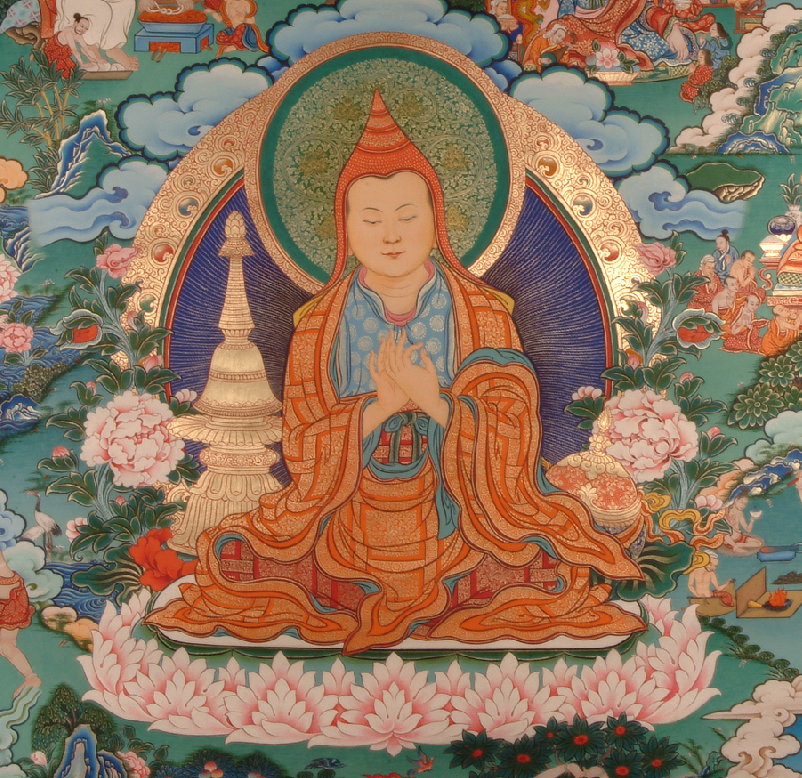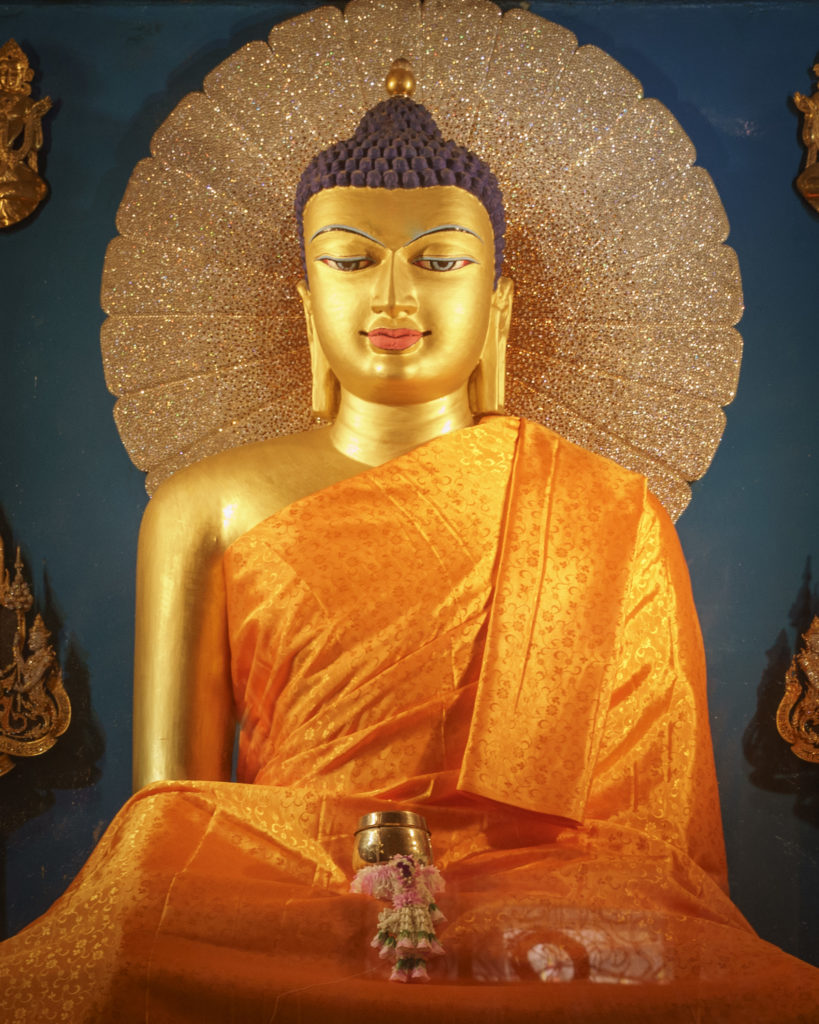Illuminating Dharma
Study and contemplation are at the heart of practice because knowledge forms the basis of every meditation.
Khentrul Lodrö T’hayé Rinpoche
The foundation of the teachings is to purely uphold vows of ethical discipline. The heart essence of the teachings is to diligently engage in the activities of meditation and study. The fruition of the teachings is to enact benefit for the welfare of others.
~ His Holiness Jigme Phuntsok Rinpoche

Buddhism is a spiritual path that seeks to eliminate the causes of suffering and create those of genuine happiness. This is a path taught by buddhas. A buddha is anyone who, by practicing the path, has eliminated their ignorance and disturbing emotions, which are the root causes of suffering. To accomplish this, buddhas have awakened to the ultimate nature of reality, which is resplendent with positive qualities.
Every living being is searching for happiness and trying to avoid suffering. However, when we seek satisfaction in the external world –- people and objects outside of ourselves –- we discover that it never lasts long. All things are impermanent and constantly changing by their very nature, and our inability to recognize this leads us into disappointment and pain. As long as the causes of authentic happiness are absent, and those of suffering are present, nothing we do will ultimately free us from suffering nor bring about lasting contentment.
The Buddhist path is the gradual process of cultivating the causes of happiness and eliminating those of suffering within our own minds. Three principles form the basis of the path: the determination to be free of the cycle of suffering known as samsara, great compassion, and wisdom. With this basis, the practitioner tames their own mind, refining away its flaws and revealing its innate positive qualities. We benefit ourselves by eliminating the causes of suffering and attaining ultimate happiness, and we benefit others through actions that spontaneously manifest from having perfected the qualities of love, compassion, and wisdom.
The Buddha’s teachings and practice can be summed up in two points:
- The view of interdependent origination
- The conduct of doing no harm
The view of interdependent origination means we understand that everything occurs due to cause and result. All causes have results, and all results are linked to causes; everything that occurs does so as a result of its specific causes and conditions. The root cause of our experience of samsara is ignorance (the nonrecognition of our own true nature), from which arises our disturbing emotions and their subsequent actions (karma in Sanskrit). Hence, the path is a series of methods for decreasing the negative thoughts, emotions, and actions that cause suffering, while cultivating positive thoughts, qualities, and wisdom, which result in happiness.
The conduct of doing no harm means that we base our actions on avoiding harm to other beings. Living beings are called sentient beings because they have mind, which is conscious and aware, and hence they experience sensations of pleasure and pain. Like us, all sentient beings seek positive sensations and try to avoid painful ones. Even tiny creatures such as ants move toward pleasure and away from pain. With this perspective –- that all beings want happiness and seek to avoid suffering –- Buddhists strive to engage in actions that are positive and to refrain from those that are harmful.
Further Studies:
Do no harm whatsoever.
Perfect positive actions.
Completely tame your mind.
This is the teaching of the Buddha.
~ The Buddha Shakyamuni
What is the Basis for Taming the Mind?
The basis for taming the mind is the originally pure and perfect nature of our mind itself. In the Buddhist tradition, the mind’s true nature is described as the primordial unity of luminosity and emptiness, also known as “buddha nature.” This pure nature is the essence of every living being’s mind, and it is upon this basis that every one of us has the potential to tame our own mind.

What is to Be Tamed?
What is to be tamed, meaning eliminated, are those factors that obscure the positive qualities of our buddha nature and cause suffering. This includes ignorance, deluded perceptions, disturbing emotions, harmful actions, and the karma that results from all of these. By taming the mind, we seek to address the root cause of suffering –– ignorance and the other factors that flow from it.
What is the Fruition of Taming the Mind?
The fruition of taming the mind is both temporary and ultimate peace and happiness. This means creating more causes of happiness and eliminating the causes of suffering, which ultimately leads to a complete cessation of suffering and ultimate happiness, or enlightenment.
What Tames the Mind?
An authentic path is one that tames the mind by providing methods such as meditations and contemplations that lead to happiness and eliminate suffering.
How Do We Tame the Mind?
We begin the process of taming our minds by relying on a qualified teacher –- in the Tibetan tradition, a lama –- who comes from a pure and authentic lineage. In this context, “lineage” means that the wisdom and compassion of the practice have been passed down from teacher to student in an uninterrupted and verifiable succession.
Relying on a teacher is achieved through alternating among listening to teachings, contemplating those teachings, and meditating upon them. Taming the mind through this threefold approach in gradual stages, as originally taught by the Buddha Shakyamuni, is extremely important. If we practice according to this tradition, our practice will be complete and correct, containing the vital points that lead to spiritual maturation. As a result, we will attain the power to benefit not only ourselves but all sentient beings.

Although we may find temporary happiness from external circumstances or other people, ultimately it will prove neither lasting nor truly satisfying. Genuine peace and well-being exist only within ourselves, in our own minds. When we meditate, we discover that peace and begin to cultivate our inherent positive qualities. Our negative thoughts decrease in number and start to lose their power over us.
Initially, we need a point of focus to calm our minds. The simplest method is to focus on our breath, which is reliable, uncomplicated, and always with us.
Instructions for Foundational Calm Abiding Meditation
The purpose of meditation is to cultivate positive qualities within ourselves, and ideally to increase our capacity to benefit others. Since our experience is dependent upon our mind, motivation strongly influences the outcome of our actions. So it’s important to take a few moments to develop a kind heart — loving kindness and compassion — that is, the wish that living beings find happiness and be freed from suffering.
To begin practicing calm abiding meditation [shamatha], it’s helpful to find a quiet space conducive to settling the mind. This could be a room in your house or a beautiful area outside where you won’t be seen or disturbed. Sit on a cushion, on the floor or on the ground, or use a chair if that is more comfortable. Keep your back straight and allow your gaze to rest softly in the space in front of you. Relax your jaw so that your mouth is slightly open.
Notice your breath as it enters and leaves your body. After a while, try counting your breaths, with each inhalation and exhalation considered one breath. Continue counting until you reach twenty, then begin again. If you lose track of the count, gently start over with number one. Alternatively, you can count your breaths using a mala (a Buddhist rosary). Traditionally, the mala is held in the left hand, and on each count you draw one bead toward you with your thumb.
Notice thoughts as they arise, but don’t let your mind follow after them; allow them to dissolve naturally into space as you gently maintain focus on the rising and falling of your breath. If you find yourself carried away by a stream of thoughts, don’t worry about it –- just recognize what has happened, let the thoughts go, and return to following your breath.
Eventually, calm abiding meditation leads to qualities of stillness and clarity. The mind does not shut down, but rather becomes naturally clear and still. The process is sometimes likened to leaving a glass of muddy water on a windowsill. When the water sits still long enough, the sediment settles to the bottom and the water clears. The moment-by-moment awareness of the breath leads to stillness. Leaving your eyes and all other sense faculties open while focusing on the breath generates clarity.
Additional Advice
Two tools: These are mindfulness and vigilant guard. Mindfulness in this context means to remember the object of meditation in each moment – in this case it means remaining aware of the breath. Vigilant guard means checking your mind regularly to see if its attention continues to rest on the object of meditation, or if it has become distracted.
Short sessions many times: When you’re new to meditation, it’s best to keep your sessions relatively short so you don’t get tired, bored, or sore. Instead of sitting for thirty minutes straight, you might sit for five or ten minutes at a time to begin with. If you like, you can also take brief breaks within sessions; for example, you might count twenty breaths, let the mind rest without holding that focus, and then repeat. You can naturally extend the time of your sessions as you grow more comfortable, both physically and mentally.
Not too loose; not too tight: Another key point is to find just the right balance of relaxation and effort, like finding the right tension on the strings of a guitar. If the strings are too loose, they sound terrible; if they’re too tight, they break. We need just enough effort to remember our meditation object, but not more. Ideally, our minds will be relaxed, but not so relaxed that we lose focus on the breath.
Further Studies:
For more videos of Khentrul Rinpoche’s various activities, please visit his YouTube channel. Be sure to subscribe if you wish to be notified whenever new content is added.
- Teachings
- The Power of Mind
- Mind and Mental States
- Instructionals
- How to Setup your Shrine
- Becoming Familiar with Your Practice Texts
The Power of Mind
A summary of the key points from Khentrul Rinpoche’s new book The Power of Mind. Recorded live at the Rime Center in Kansas City on August 14, 2022.
Mind and Mental States
Making this Human Life Meaningful
How to Search for Ultimate Peace
Introduction to Meditation
The Purpose and Way to Practice
Turning Away from our Disturbing Emotions
Finding Joy in Troubled Times
The Four Seals
Tonglen: The Bodhicitta Practice of Giving and Receiving
Many of Khentrul Rinpoche’s talks are recorded. For weekend talks, especially those using a text, you must have attended the teaching to listen to the recording. For more information contact gro.g1767263266otak@1767263266sgnid1767263266rocer1767263266.
